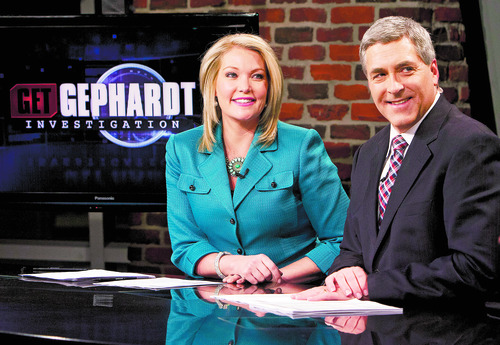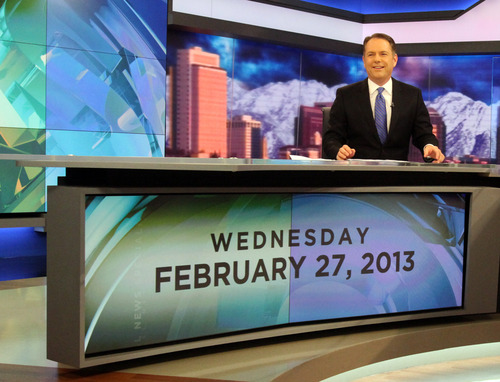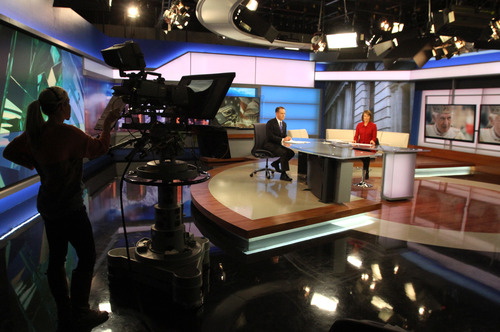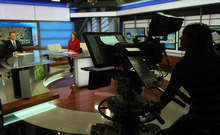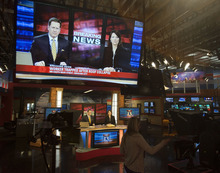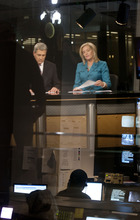This is an archived article that was published on sltrib.com in 2013, and information in the article may be outdated. It is provided only for personal research purposes and may not be reprinted.
The latest Nielsen ratings out last week underline what now must be painfully clear to KSL-TV. Its storied news operation, which ruled the airwaves for decades, is now firmly stuck in second place behind its surging rival KUTV, and a quick recovery is unlikely.
For two years, through seven ratings periods, NBC affiliate Channel 5 has fallen further behind Channel 2, the CBS affiliate. Today, the gap between LDS Church-owned KSL and the secular KUTV is the widest it's ever been — a humbling that has observers inside and outside the two stations searching for answers and pointing fingers.
Many who know both stations well say the blame for KSL's long fall rests on the shoulders of one man: Mark Willes, the hard-charging, self-assured nephew of former LDS President Gordon B. Hinckley.
Willes, something of a media enfant terrible in the 1990s when he ran the Los Angeles Times and its parent, Times Mirror Co., accepted a call four years ago from the First Presidency of The Church of Jesus Christ of Latter-day Saints to take the reins of Deseret Management Corp., putting him in charge of KSL and the church's other media properties.
He moved quickly to make his mark, launching a values-based news strategy that was opposite the magisterial, hard-news approach favored by Hinckley and which had garnered huge audiences for KSL, burnished the stature of the church and earned it big profits.
"He was the beginning of the end," said Don Gale, a former vice president of news for KSL's parent company, Bonneville International. "[Willes] didn't understand broadcasting."
Willes, who declined to be interviewed for this story, is no longer at Deseret Management. He was dismissed in April after three years on the job. Willes acquiesced to what was said to be his retirement, but people who know him say he wasn't ready to go, even though he was 70 years old.
The end came about a month after Nielsen released its February 2012 ratings of Salt Lake City TV news broadcasts. For KSL, the ratings were another embarrassment. For every two households tuned into KSL's late-night program — traditionally its most lucrative news show — three were watching KUTV. (Ratings represent the percentage of all homes with televisions tuned to a program.)
The explanation for KSL's tumble is straightforward, KUTV General Manager Kent Crawford contends. Viewers don't like what they see on KSL and are seeking out an alternative for their news. Willes was a risk-taker eager to reinvent KSL, Crawford said, but the softer approach he championed hasn't worked.
"They don't see the style of news that they've been used to seeing from KSL for many years. They see something else. I think the viewers are very savvy, and they see KSL doing some things that are nontraditional in their approach," Crawford said.
"I don't think the viewer really resonates with that. Nor do they care," he added. "They would rather have an informative newscast that is prepared professionally and delivered in a manner and style that they would like. I think that's a big factor."
Like newspapers, TV news is under immense pressure from the Internet and the devices that allow people to get news whenever they want. Yet KSL's ratings slide is "unusual" for its severity, said Rick Gevers, a former television news director who is now an Indianapolis-based agent representing on-air TV personalities. The station's preference for softer news runs counter to what he's noticed lately.
"There seems to be a renewed interest and appetite and emphasis on covering hard news and investigative reporting," Gevers said, recalling an Investigative Reporters and Editors conference he attended recently. For the first time in a while, the number of television stations represented at the conference was noticeably larger. Some were actively recruiting.
"It was like somebody woke up and said, 'Gee, content matters,' " Gevers said. "So as people put more attention into content and coverage, presumably there's an appetite among the viewers. A station that might be doing less of that would be impacted."
Willes is an analytical personality whose training seems at odds with soft journalism. A Utah native, he earned a doctorate in economics from Columbia University. In 1977, at age 35, he became the youngest president of a Federal Reserve Bank (in Minneapolis). Before joining Times Mirror, he was vice chairman of General Mills, the breakfast cereal company.
After moving to Times Mirror, he earned nicknames like Cereal Killer and Iron Willes for demanding sweeping cuts at the Times and closing the unprofitable New York Newsday paper. At the dawn of the Internet age, he argued that newspapers could flourish only if they reinvented themselves. Yet he has said few things are more satisfying than good journalism, and while Willes was in charge, Times Mirror papers won Pulitzer after Pulitzer.
He proved to be no less controversial in Salt Lake City. Shortly after his arrival, Willes announced his values-based model. In part, the strategy was meant to stem circulation losses at the Deseret News, which, like most newspapers, had been battered by plummeting advertising and the shift of readers to online news sources.
But there was a second purpose. It was also meant to advance the societal views of LDS leaders that might be palatable to Mormons and non-Mormons alike.
"At the end of the day, there is only one reason to own businesses like these, and that is [to] reflect well the kinds of values they stand for," Willes said in a Salt Lake Tribune interview three years ago.
KSL executives said they don't know why Willes suddenly left, but they don't fault him for the station's woes. They say there were signs that KSL's hold was weakening long before Willes set in motion what internally they call "solutions" journalism. Rather, a potent brew of weak NBC prime-time programming over several years, the loss of longtime anchors Dick Nourse in 2007 and Bruce Lindsay last year, an explosion of digital devices that changed viewer habits — even an expensive on-air news desk with three anchors instead of two — produced KSL's lower ratings, the executives say.
"I bet if you call other markets and ask NBC how it's going, you would see a similar story, and they haven't changed their set or changed their anchors," Bonneville Chief Executive Jeff Simpson said. "We've done both of those [things], and at a time when people are changing their news habits, and we are trying to respond to that. It makes it tumultuous, for sure."
"The anchor change is a short-term difficulty," acknowledged Tanya Vea, KSL's executive vice president of news. "We've got great people [in Dave McCann and Mike Headrick, who joined veteran Nadine Wimmer as anchors last year]. But it takes time for viewers to get to know them and connect with them.
"We can't do anything about that," Vea said, "other than give them time and then start to transition and build our content so that it's so strong and so compelling that that is what people are talking about."
Lindsay's departure to head an LDS mission in Australia was a blow, and KSL's viewers clearly didn't want him to leave. Neither did Vea and Simpson. Lindsay's last 10 p.m. broadcast briefly bumped KSL up to a 12.2 rating, besting KUTV by 2.1 ratings points before sinking back the next night. Lindsay, though, may have been glad to go. Gale, the former Bonneville news vice president, said Lindsay didn't like the new course KSL had set.
"Bruce was not happy," Gale said. "He was not pleased with what was going on over there. They were doing soft stories, and it was always fires and shootings. The thing we used to criticize in other stations suddenly became bread and butter for KSL, and they didn't do it very well."
Attempts to contact Lindsay through the LDS Church headquarters were unsuccessful.
Asked in an interview last week how they intend to revive the late-night news broadcast, Simpson and Vea said simultaneously that "It's a good question" without a simple answer.
"We are learning. We are growing. We are developing. We are trying things. When they don't work, we try other things," Simpson said, adding that values-based journalism is resonating with many viewers.
"We are seeing a lot of positive uptake on not this sort of poking, prodding [form of news reporting], or this sort of bipolar, bring-in-two-people-and-have-them-argue sort of journalism," he said.
Vea said KSL is reaching more people than ever, although not just through its television broadcasts. KSL.com news pages received 60 million desktop views in January from 4.4 million visitors, she said, citing data compiled by Omniture, the Lehi-based web analytics division of Adobe. The site received an additional 24 million page views from close to 600,000 mobile devices. Most of the hits were from inside Utah, she said.
Those hits aren't counted by Nielsen when it compiles KSL's ratings, underscoring Simpson's belief that the station isn't as far behind KUTV as people think.
Still, he concedes, KSL's news needs to get better if ratings are ever to turn around, especially for the critical late-night broadcast.
"We know our 10 p.m. has to evolve," Simpson said. "It has to get better, has to do a really vibrant job for the consumer. We know that's the case."
Editor's note: The Salt Lake Tribune has a relationship with KUTV in which the two news organizations occasionally share content. pbeebe@sltrib.com
Twitter: @sltribpaul —
Why ratings are important
Ratings are akin to public opinion polls. Advertisers look to them for guidance on where they should spend their money. TV stations base their advertising rates on ratings numbers. In Salt Lake City, a gain or loss of one ratings point can mean as much as $1 million over the course of a year. —
KSL ratings decline
Reasons for the decline of KSL-TV's news broadcasts from their traditional No. 1 spot include the loss of longtime anchor and reporter talent and weak lead-in NBC prime-time programs. But many people argue the arrival of Mark Willes, the controversial Times Mirror CEO, was key to the fall to No. 2 behind KUTV.
December 2006 • Weatherman Mark Eubank retires.
November 2007 • Anchor Dick Nourse retires.
February 2009 • Willes becomes CEO of Deseret Management Corp. (DMC)
March 2009 • DMC is converted from a holding company to an operating company, strengthening Willes' authority over for-profit properties such as KSL.
November 2009 • KSL is still No. 1 with a 10.3 Nielsen rating, though the station is down 1.5 points from December 2008. KUTV rating is 9.9. Ratings are for 10 p.m. news broadcasts.
January 2010 • Willes lays out values-based news strategy for KSL and the Deseret News.
February 2010 • KSL slips to 9.4 rating. KUTV rating declines to 8.2.
April 2010 • Willes takes temporary control of KSL Broadcast Group, keeps DMC CEO job.
May 2010 • KSL rating holds at 9.4. KUTV climbs to 9.3.
August 2010 • Tanya Vea, former KUTV news director, appointed DMC vice president of programming development. She will lead "origination of programming development" at KSL.
August 2010 • Drastic reporter, editor cuts at Deseret News. Remaining newsroom is consolidated with KSL.
November 2010 • KSL, KUTV ratings tied at 10.5
January 2011 • DMC and Willes announce effective immediately Con Psarras has moved from his longtime role as KSL news director to run editorials and special projects. Vea named KSL executive vice president of news.
February 2011 • KSL's 10 p.m. rating falls to 9.6. KUTV climbs to No. 1, with 11.4 rating.
May 2011 • KSL rating recovers to 9.8. KUTV holds at 11.4
September 2011 • Sinclair Broadcast Group buys KUTV.
September 2011 • KUTV station manager Steve Carlston moves to KNBC in Los Angeles.
November 2011 • KSL rating falls to 8.7. KUTV holds at 11.4.
February 2012 • KSL falls to 8.0. KUTV climbs to 12.3
March 2012 • KSL announces anchor Bruce Lindsay will retire soon.
April 2012 • Willes retires suddenly. Replaced by Keith McMullin, who says his new job was not expected.
May 2012 • Lindsay retires. KSL's 10 p.m. rating soars on his last day.
May 2012 • KSL rating is 8.1. KUTV holds at 12.3
November 2012 • KSL sags to 6.8. KUTV rises to 12.8.


